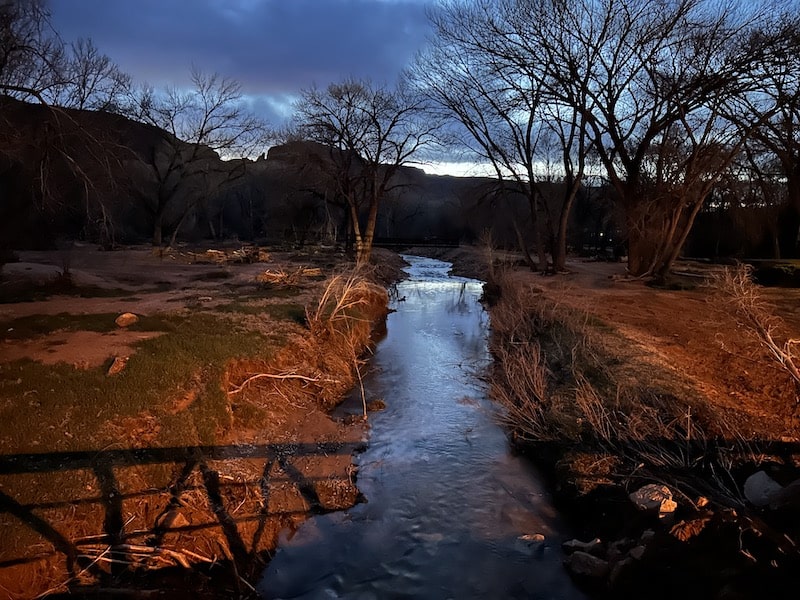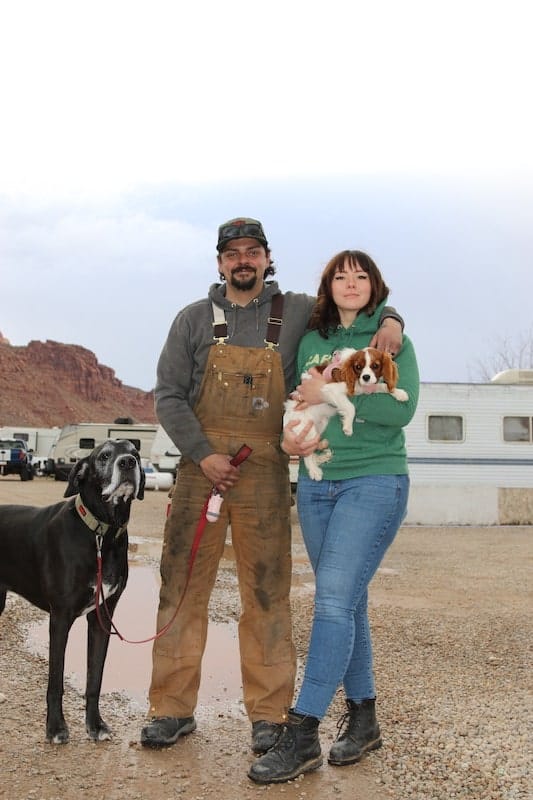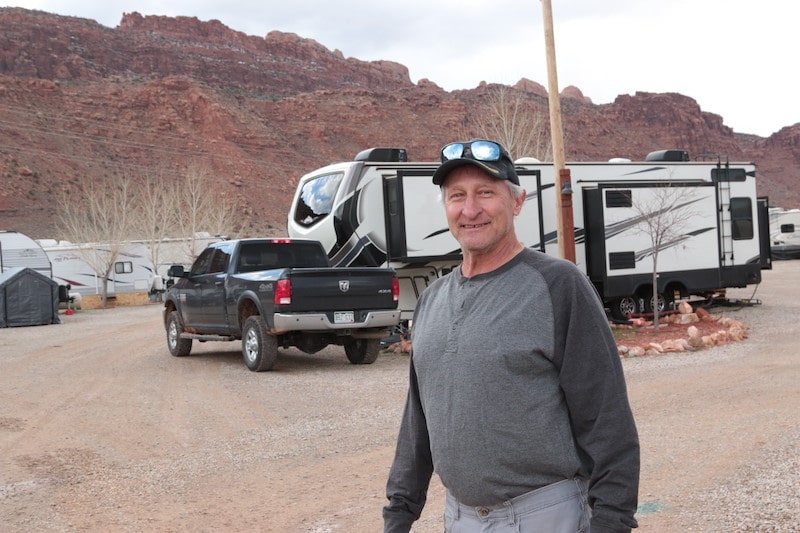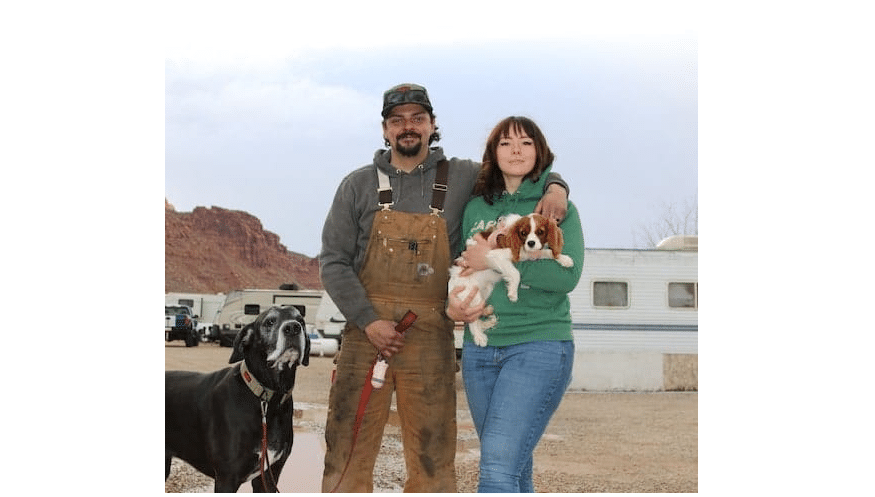
Chloe Wilson was overjoyed with the news that she had been offered a faculty position at Utah State University’s new campus in Moab, Utah. There was just one hitch: she could accept the position only after having secured housing.
Wilson, her husband Kieffer Smith, Great Dane Jacob and little Ruby headed to Moab weeks before beginning their new jobs. Both are skilled welders. However, despite their good credit, good references, and a decent amount of savings, they found they could not get into a condo in the highly competitive rental market.
“The landlord required $10,000 to move it; we just couldn’t do that … He then recommended I borrow the money from family, which I wasn’t going to do.”
Wilson and Smith felt they could have easily qualified had it not been for the huge down payment, so they decided to find another solution: living in their RV.

They leased a spot at the Moab Rim RV Campground and believed they would be secure for the coming season. But, Wilson says, as the season started gearing up, “They told us they had eight spots available year-round. We assumed that we would be in one of those spots, but then they decided to tell us we needed to leave with just a week’s notice.”
Luckily, they found a spot reserved just for construction trade workers. Dan Stott is the owner and operator of a Moab drywall company. Stott found the expense of housing his workers in town to be cost-prohibitive, so he took matters into his own hands and bought a property to convert into an RV park. Stott manages 27 units, which are a mix of RV sites and small cabins, all available only as long-term rentals. None are nightly rentals.
Wilson and Smith were able to secure a spot at Stott’s Contractor’s RV Park. While this temporary solution has solved their immediate problems, the couple does not believe that the political leaders in Moab are willing to make the difficult choices that would make a significant long-term impact on the housing shortage, especially for new residents who want to reside in Moab year-round.
Wilson and Smith believe that while most of the residents who live in Moab work in the service industry, the town is “controlled by politicians who prioritize AirBnB, VRBO and nightly rentals over affordable housing for service industry workers,” said Wilson.
Smith attended a town hall meeting where Stott was defending his rights to operate his RV park and found that the majority of politicians were against Stott’s affordable housing solution. Smith says, “They gave off a vibe that Moab is changing and they didn’t want it to change. They wanted us to be the Moab from ten years ago … [but] that Moab is dead and gone out the window a long time ago, and so you deal with a lot of opposition in that sense.”
Wilson and Smith say they still don’t regret their decision to move to Moab. “We love the city and we still feel like we made the right decision,” Wilson said. But they say that if the political leaders shift their priorities to focus on helping residents with affordable housing, it will make the entire town stronger. “We feel fortunate that we can be in a place where we can teach people a skilled trade. In town, welders are very sought after … It creates more job opportunities for locals if they have a skilled trade under their belt. They don’t have to take service-work jobs.”
Wilson and Smith agree that this creates an environment where the construction industry, which isn’t tourism-dependent, can provide the steady income that would provide a more viable economy by allowing more couples to make ends-meet, have children and create a less tourism-dependent town.
“We are the ones at the bars and restaurants when there are literally zero tourists here. We can make all of the tourism-dependent restaurants stronger by staying here [year-round],” says Smith.

Dan Stott’s RV park is on the south end of town. He says that he could immediately double the size of his park and add another 25 sites, but the city decided to almost triple their “impact fees”. When Stott initially built his park, the impact fees were $1,800 per unit. Stott says the city now wants $5,800 per unit or over $1 million total. Stott is currently at odds with the City Council and Mayor because he wants to provide the necessary bridge between unaffordable housing for residents who want to live in Moab year-round. “We have nurses, city employees, and electricians all living in this RV park.”
Stott says that most of them would have no other place to live if it weren’t for his RV park. His RV pads, including sewer and utilities, are around $850 per unit. Studio apartments in Moab start at $1,500, and two bedrooms start at around $2,600. Working class residents filling these important roles in town (including Smith and Wilson) would literally have no other place to live if it weren’t for Stott and his decision to make his “conditional-use” land for long-term renters rather than short-term rentals. “This town needs affordable housing for contractors,” he says.
Some of Stott’s residents have remained in his park for more than four years and still don’t know how they could ever afford an actual home. As for Wilson’s and Smith’s long-term plans, “We realize the only housing available is around half a million; that would be around $4K per month. Maybe one day we can afford that.” But Wilson adds that won’t be anytime soon. “We are not able to qualify for any of the low-income housing programs (such as Community Rebuilds or Sweat Equity).”
This is a problem and sentiment most Moab professionals I spoke to share. The barrier to entering those programs was set prior to the massive inflation of both Moab’s housing and labor costs. What’s the solution? Stott, Smith and Wilson all agree that a shift in priorities from Moab’s leaders is required.




